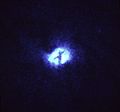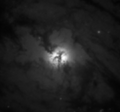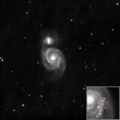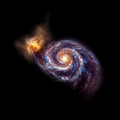Whirlpool galaxy facts for kids
Quick facts for kids Whirlpool galaxy |
|
|---|---|
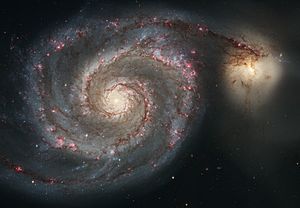
|
|
| Observation data (J2000 epoch) | |
| Constellation | Canes Venatici |
| Right ascension | 13h 29m 52.7s |
| Declination | +47° 11′ 43″ |
| Redshift | 463 ± 3 km/s |
| Distance | 23 ± 4 Mly (7.1 ± 1.2 Mpc) |
| Type | SA(s)bc pec |
| Apparent dimensions (V) | 11′.2 × 6′.9 |
| Apparent magnitude (V) | 8.4 |
| Notable features | Interacting with NGC 5195 |
| Other designations | |
| Question Mark Galaxy, Rosse's Galaxy, M51a, NGC 5194, UGC 8493, PGC 47404, VV 001a, VV 403, Arp 85, GC 3572 | |
| See also: Galaxy, List of galaxies | |
The Whirlpool Galaxy, also known as M51a or NGC 5194, is a famous galaxy with beautiful spiral arms. It has a smaller galaxy, NGC 5195, that it is currently interacting with. These two galaxies have been through a cosmic collision!
The Whirlpool Galaxy was the very first galaxy to be recognized as a spiral galaxy. Imagine, before this, scientists didn't know galaxies had these amazing swirling shapes! It is one of the most well-known galaxies in the night sky.
Scientists have used different ways to figure out how far away the Whirlpool Galaxy is. It's estimated to be about 23 million light-years from our own Milky Way galaxy. That's a super long distance!
Its spiral arms are so clear and impressive that it's called a "grand design" spiral galaxy. At its center, it has an active galactic nucleus. This means there's a very bright, active region, likely powered by a huge black hole.
Contents
What is the Whirlpool Galaxy?
The Whirlpool Galaxy is a stunning example of a spiral galaxy. It looks like a giant cosmic pinwheel. Its official name is Messier 51a, or M51a for short. It's also known as NGC 5194.
This galaxy is famous for its very clear and well-defined spiral arms. These arms are made of gas, dust, and billions of stars. They swirl outwards from the galaxy's bright center.
How Big is the Whirlpool Galaxy?
The Whirlpool Galaxy is quite large, stretching about 60,000 light-years across. To give you an idea, our Milky Way galaxy is about 100,000 light-years wide.
The galaxy is located in the constellation Canes Venatici, which means "Hunting Dogs." Even though it's far away, it's bright enough to be seen with binoculars. This makes it a favorite target for both amateur and professional astronomers.
How Does the Whirlpool Galaxy Interact with its Neighbor?
The Whirlpool Galaxy is not alone in space. It has a smaller companion galaxy called NGC 5195. These two galaxies are very close to each other. They are even connected by a bridge of stars and dust.
What Happens During a Galaxy Collision?
The Whirlpool Galaxy and NGC 5195 are currently in the middle of a slow-motion collision. When galaxies collide, it's not like cars crashing. Instead, the stars usually don't hit each other because space is so vast.
However, the gravity of each galaxy pulls on the other. This pulling causes big changes in their shapes. For the Whirlpool Galaxy, this interaction has made its spiral arms even more noticeable. It's like the smaller galaxy is tugging on its arm, making it stretch out.
Scientists study this interaction to learn more about how galaxies grow and change over billions of years.
What is Inside the Whirlpool Galaxy?
Like most large galaxies, the Whirlpool Galaxy has a supermassive black hole at its center. This black hole is incredibly powerful. It pulls in gas and dust, making the center of the galaxy very bright. This bright center is what we call an active galactic nucleus.
The spiral arms are also home to many new stars forming. These areas look blue because of the hot, young, massive stars that shine brightly there.
How Can We See the Whirlpool Galaxy?
The Whirlpool Galaxy is a popular object for people who enjoy looking at the night sky.
Viewing with Binoculars and Telescopes
You can actually see the Whirlpool Galaxy with a good pair of binoculars if the sky is dark enough. It will look like a faint, fuzzy patch of light.
With a small telescope, you can start to see its spiral shape. Larger telescopes show even more detail, including the distinct spiral arms and the smaller companion galaxy. It's a truly amazing sight!
Professional astronomers use powerful telescopes like the Hubble Space Telescope to study the Whirlpool Galaxy in great detail. They learn about its structure, how its arms formed, and how galaxies interact with each other.
Images for kids
-
Sketch of M51 by Lord Rosse in 1845
-
Supernova impostor AT2019abn, imaged by the Hubble Space Telescope
See also
 In Spanish: Galaxia Remolino para niños
In Spanish: Galaxia Remolino para niños




